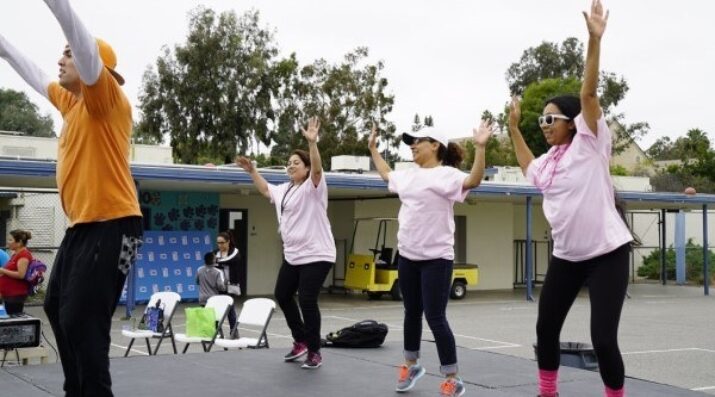Setting Wildly Important Goals: From School to Classroom
Topics

Next generation learning is all about everyone in the system—from students through teachers to policymakers—taking charge of their own learning, development, and work. That doesn’t happen by forcing change through mandates and compliance. It happens by creating the environment and the equity of opportunity for everyone in the system to do their best possible work.
Mission Vista High School in the Vista Unified School District uses Wildly Important Goals to distribute leadership and move forward with personalized learning.
When a school transforms learning, who owns the transformation?
At Mission Vista High School (MVHS), ownership extends well beyond positional leaders. Teacher leaders, like department chairs and professional learning community (PLC) leads, serve as decision-making teams—these are the people with boots on the ground.
Although some of these positions—like department chairs—are common at any high school, department chairs and PLC leaders work with their groups to co-create their own goals, what we call wildly important goals or WIGs, aligned with the school goals; set the agenda and success indicators for the work; and create scorecards to track progress. Teachers also design and facilitate professional learning experiences to support department, PLC, and school-level WIGs.
Teachers also engage in collaborative planning, prioritizing, and problem-solving to support achievement of these goals. For example, five years ago, we piloted a senior capstone course called My Vision Personalized, and we did this in spite of low enrollment. The first year, we ran a section with 11 students. That’s something that we would never normally do in a school serving 1,600 students. It was going to mean larger class sizes elsewhere, but we went ahead with the pilot because it aligned to our goals and the teachers in that particular department were on board with it. It was a huge success; we knocked it out of the park with the 11 students, and the next year we more than doubled the enrollment.
Funding of teachers’ time is a value statement that sends the message: “We value the work that you’re doing, the strengths that you bring to the table, and we want to support this work.”
Similarly, our site-based decision making committee made the decision to offer release periods to Michelle Daum, the English department chair, to serve as a teacher on special assignment in support of the school’s personal learning (PL) goals. In this role, Michelle acts as a teacher leader and coach for supporting educators to personalize their content and instruction. As a committee, we made this agreement even though it means we will sacrifice sections in the master schedule and increase class sizes elsewhere. Why? Because we believe this is powerful work.
Those are the types of decisions we make that are aligned with our values and the work we want to do.
Teacher leaders also model vulnerability and foster a change-positive culture by sharing their own practices and artifacts—even those that are not successful. Teacher leaders do this all the time at MVHS. Being okay with trying something new, even if it doesn’t work, is important to show teachers who are used to being successful in their work.
Whether or not individual educators choose to take on leadership roles, all teachers at MVHS exercise autonomy by choosing their own WIGs each year. Carrying on a tradition launched by Nicole when she was the principal of MVHS, Jeremy meets with each teacher at the start of the school year.
We ask every single faculty member to set a personal WIG for the year, and at our one-on-one meetings, we talk about their wildly important goal. How does it support the school-wide goals? What do they need for support?
We provide support for teachers’ personal WIGs in many forms, from a great book to a conference to equipment for the classroom. However, time is the number one resource teachers ask for. The vast majority of personal learning dollars go to pay teachers for the extra hours teachers would put in anyway—to write curriculum, to collaborate with colleagues, to transform their classrooms as they try things that they’re passionate about. This funding of teachers’ time is a value statement that sends the message: “We value the work that you’re doing, the strengths that you bring to the table, and we want to support this work.”
Those individual WIG meetings, hands down, are the most important thing that we have done with our staff, in our roles as principal, to move the work forward. We highly recommend to school leaders to set 15- to 30-minute meetings during the first four weeks of the school year with every teacher on campus. It’s amazing hearing about what teachers are fired up about doing for kids.
We’ll end on a comment by Michelle. Speaking as a teacher-leader, Michelle describes how our school’s culture of mutual support and shared ownership of the learning transformation creates a bond of trust that supports our school community during challenging times. She says,
“There’s something special about this place. There’s something about us all trusting each other and wanting to work together. Creating that community as a staff and creating that community with our students. That’s something we’ve grown in, especially through COVID, and it’s really become clear that it’s something we value.”
Learn More about Teacher Leadership for Personalized Learning at Mission Vista High School
- Supporting Students to Drive Their Learning in ELA
- Personalized Learning in Social Science: Skills, Agency, and Relevance
- Personalized Learning in Photography: Discovery, Innovation, and Growth
- Personalized Learning and Math: Not Just about the Numbers
- Learner-Centered Assessment: Senior Capstones Measure What Matters
- Learner-Centered Assessment: Grading for Competency
This article is an excerpt from the NGLC publication, Sharing Power for a Shared Vision: Change Agent Leadership at VUSD.
Photo at top courtesy of Vista Unified School District.




